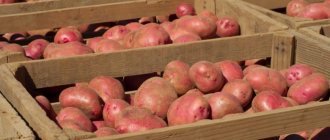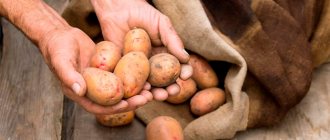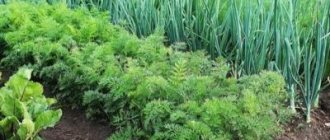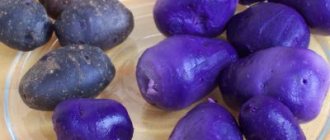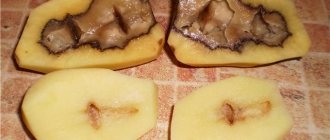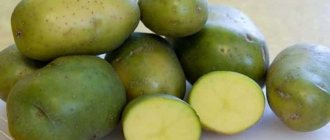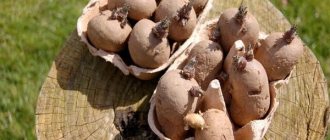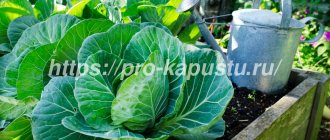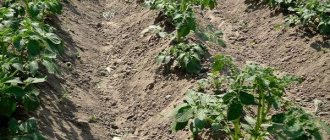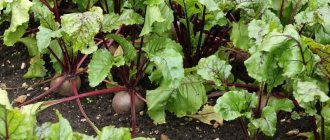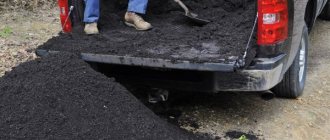Home / Landing
Back
Published: 03/07/2020
Reading time: 21 minutes
0
23
- 1 Potatoes turned green in the light: can they be eaten?
- 2 Green potatoes - can they be eaten?
- 3 Why do potatoes turn green?
- 4 What happens if you eat green potatoes?
- 5 Reasons for germination
- 6 Potatoes turn green during storage, what should I do?
- 7 Why does it turn black inside?
- 8 Diseases
- 9 Tips for proper storage
Potatoes turned green in the light: can they be eaten?
Processes do not occur in the ground, cellar or in a dark room, so the potatoes retain their natural color. Only when direct sunlight hits it does photosynthesis occur, thereby turning the upper part of the fruit green. Many noted that, in connection with this, the taste of the fruit changes, they become bitter with an unpleasant taste and smell. This is due to the processes of photosynthesis and the release of a certain poison.
Potatoes turn green in the light, what poison is produced:
- These fruits contain a substance called solanine. This is a glycoside, one of the strongest poisons. It was first discovered in 1820, but then the shoots, leaves, stems and green tubers of potatoes were used to make insecticides.
- Scientists have noticed that the product prepared from potato shoots is very effective against a large number of insects and pests. It began to be used for spraying garden plots and vegetable gardens. It was then that the opinion arose that green potatoes should not be eaten.
- At the moment, solanine, as well as alkaloid glycosides, are widely used in medicine. They are usually used in the manufacture of cardiac remedies, which increase blood circulation and also make the blood thicker. This can sometimes save a person during a heart attack. Alkaloid glycosides are also used in the treatment of severe toxicosis in pregnant women.
Green tubers
If potatoes are green, can they be eaten? It is best to throw out this root crop or put it to seed. But you can clean it well, cut off all the green part and stew it. Of course, all the solanine will not go away, but there will be much less of it. Half of the poison will go into the water, into the oil.
Green potatoes - can you eat them?
What makes potatoes turn green? The reason for the greening of the tuber is a natural process. When sunlight hits potatoes, the process of photosynthesis occurs and because of this, the color of this product changes.
It is not advisable to eat such potatoes. Can green potatoes be eaten if cut? Even if you cut off the skin in a thick layer, the green tuber is harmful to health.
Are green potatoes dangerous for your health? Potatoes contain the poison solanine. Its content does not exceed 0.05%. But if the tuber is exposed to sunlight, ultraviolet or infrared rays, then the content rate begins to increase. Therefore, green potatoes are not suitable for eating.
Solanine poisoning
Like any other, potato poisoning and not treated on time lead to the death of a person.
If poisonous potatoes come across the table, then you should get rid of them, even if they have already been cooked - it is better to refuse to eat such food altogether than to suffer later. In general, it’s not worth eating.
When corned beef enters the stomach, it begins to act almost instantly - the first thing that suffers is the mucous membrane and the entire gastrointestinal tract. The body tries to get rid of the poison in any way possible - vomiting and diarrhea appear.
Doctors say: if vomiting has started, it does not need to be stopped artificially; the maximum amount of spoiled product should come out of the body. The same goes for diarrhea.
Once again: why corned beef in potatoes is dangerous - it causes convulsions, thickens the blood, and increases the heart rate. All this is dangerous to human health. This is why storing vegetables must be correct. If in the store you saw potatoes in a net or just in a bucket, already green on the sides, there is no need to buy them.
And to the question: is it possible to eat green potatoes, it is better to answer in the negative.
Why do potatoes turn green?
Solanine is a strong poison; it is normally found in ordinary potatoes, which have a natural yellowish or pinkish tint.
Why are green potatoes dangerous?
- Light fruits have a very low concentration, approximately 0.05%.
- But closer to autumn and spring, with improper storage and exposure to direct sunlight, this poison is released as a result of chemical reactions under the influence of ultraviolet rays.
- Due to this, the part of the potato that was exposed to sunlight turns green. This suggests that it is in these areas that the maximum concentration of solanine is found.
Effects of solanine on the human body:
- Causes inhibition of all parts of the nervous system
- Promotes the breakdown of red blood cells and their destruction
- Promotes poor digestion and interferes with food digestion
- Impairs vision
- Increases body temperature
For sale
Many women have a question: is it even possible to eat potatoes that have turned green? To this day, there are sources that indicate that such potatoes cannot be eaten, they must be thrown away immediately.
Is it possible to eat green potatoes if the green part is cut off?
- However, in most cases, housewives are in no hurry to part with even such tubers. Here's what scientists say about this. This glycoside is destroyed when exposed to high temperature and heat treatment.
- If the housewife peels such a potato tuber, cuts it into pieces, fries or boils it, then all the glycoside will turn into absolutely safe components that will not contribute to poisoning.
Potato bushes
Yes, but only if you eat them raw. The main symptoms of solanine poisoning are:
- Headache
- Diarrhea
- Vomit
- Pupil dilation
- Blurred vision
- Temperature increase
If this is some kind of severe case, then coma occurs, as well as convulsions. In fact, there have been practically no cases of poisoning with this glycoside due to potatoes.
We suggest you familiarize yourself with Propagation of thuja by cuttings at home: how to grow thuja from a twig
Are green potatoes dangerous?
- It should not be given to animals. Owners of pigs, who are often fed rotten vegetables or scraps and potato peels, should think about this.
- If you have a large amount of green potatoes, under no circumstances should you feed them to animals without heat treatment.
- If you want to feed your cattle with these potatoes, you need to prepare them and boil them.
- Accordingly, you should never feed them raw tubers that have turned green.
Oddly enough, in 1840 in Russia they were forced to plant potatoes. At this time, Europe already knew that such fruits, as well as bushes, contained solanine, which was a harmful poison. Therefore, potatoes were not eaten at all in Europe at that time, the same thing happened with tomatoes. Accordingly, such plants were used for bouquets and decorations. Usually, they were simply used to decorate clubs and greenhouses, and were grown as ornamental plants on window sills.
Poisoning from potatoes:
- The culture led to the potato riots that occurred in 1840 and 1844 in Russia. The initiators of the riots were peasants who were forced to plant potatoes and eat them. However, due to ignorance and little reliable information, most of them did not know how to eat the crop.
- There were many cases where peasants ate not only tubers, but also tops and bushes. In addition, raw fruits were eaten. As a result, the tubers that lay in the light turned green, and the concentration of solanine in them increased. After a person ate one or two green potato tubers, he began to feel unwell, dizzy, nausea and vomiting. That is why peculiar riots arose; the peasants believed that the authorities wanted to poison them.
- The government, in turn, introduced mandatory potato plantings for the reason that for several years in a row there had been a poor grain harvest, so it was not possible to feed everyone. The amount of food decreased, and therefore the number of people who wanted to rebel increased.
- Sowing potatoes was one of the ways to protect themselves from hunger, but the peasants rebelled, since it was necessary to allocate for sowing the land on which grains had previously grown. The government forcibly forced the crops to be changed from grain to potatoes. Because of these poisonings, which often occurred due to ignorance, the peasants resisted by avoiding planting the crop.
Potato bushes
Potatoes are capable of photosynthesis, like all plants. Typically, potato tubers are in the ground, in almost complete darkness. However, if they are exposed to light, the chlorophyll in the skin will react with carbon dioxide and water, causing the potato to turn green.
Chlorophyll itself is harmless to health, but in greened tubers the concentration of solanine increases. This substance is poisonous to humans, so eating such potatoes is dangerous. It will even taste bitter. It can be used for seedlings, but if the potatoes were stored as a food product, they will have to be thrown away.
To avoid this problem, potatoes must be stored in a dark place. A cellar, pantry or insulated balcony would be suitable. The main thing is to close it from sunlight. A small amount of potatoes can be kept in the refrigerator, away from the freezer.
The root vegetable, namely under the skin, contains chlorophyll. And when the rays hit it, photosynthesis occurs. Chlorophyll is found in all plants, and some root vegetables turn purple. When potatoes are underground, they do not turn green simply because sunlight does not reach there.
If the potatoes turn green in the cellar, it means they were stored incorrectly. This product should be placed in light-proof bags and not in nets or various boxes. Do electric light turn potatoes green? Yes, electric light also turns potatoes green.
Of course, if you eat one potato, nothing will happen. But eating in large quantities, or in any quantity, is dangerous to health. Solanine poisoning will occur. Solanine is a glycoalkaloid. This substance is found in nightshade plants. Solanine is used to control local pests as well as fungal diseases.
We invite you to familiarize yourself with Hedgehogs for processing potatoes with your own hands, dimensions
Have you ever had green potato poisoning?
Yes, we were poisoned. No, we never did.
The poison enters the stomach and the mucous membrane immediately begins to suffer, and then the entire gastrointestinal tract. To get the first stage of poisoning, you only need 20 mg of this substance (one tuber contains 0.05%). For serious poisoning, you will need to consume more than 2 kg of unpeeled potatoes.
Solanine begins to affect the nervous system. It also destroys red blood cells, disrupts the gastrointestinal tract and digestion. This substance also negatively affects the kidneys. In case of severe poisoning, the human skin begins to suffer. In case of mild poisoning, the body, as they say, will begin to heal itself. Severe nausea, vomiting, and diarrhea will appear.
- Pupil dilation.
- Dizziness.
- Vomit.
- Severe diarrhea.
- Cramps all over the body.
- Weakness.
If you have eaten green potatoes and the main signs of solanine poisoning appear, then:
- Rinse the stomach with a weak solution of potassium permanganate;
- After vomiting stops, drink activated charcoal;
- The victim can also be given milk, raw egg, banana puree;
- You can also take saline laxatives;
What is solanine and why is it harmful?
Solanine is a poisonous glycoside that is produced in plants of the nightshade family and is found in any part of the plant. As for potatoes, there is especially a lot of solanine in the peel and sprouts.
In regular potato roots the level of solanine is 0.005%, in green tubers it is much higher. Upon reaching maturity, the vegetable becomes whitish, yellowish or reddish depending on the variety, and the solanine content decreases. And the fruits can be eaten after heat treatment.
Attention! Solanine is toxic to humans even in small doses. It causes stimulation and depression of the nervous system, then depression and destruction of red blood cells. High doses of the alkaloid can cause fever, convulsions, and dehydration, which can be fatal for a weakened body.
Reasons for germination
Such spots indicate the beginning of photosynthesis. If the potatoes are not completely covered with a green tint, but only with spots, then the solanine content in it is not exceeded. This product can be eaten. The main thing is to clean it well and cook it tasty. In general, experts do not advise eating even such a root vegetable. But this is everyone’s business. As they say, at your own peril and risk.
A potato tuber is a nutrient-packed version of a bud. Its goal is to germinate in the spring and form a new plant. This process starts when it gets warm enough. Sprouted tubers become less nutritious as starch is used up for germination.
If the potatoes sprouted during storage, this means that the storage is too warm. Elevated temperatures can also develop in the depths of the stockpile if ventilation is insufficient. The sprouts are dangerous to eat, so they will have to be cut off. The potatoes must be sorted and placed so that the optimal amount of air enters.
So, to prevent germination, the room with the potatoes should be well ventilated and cool (but not too cold, otherwise the flesh will begin to darken).
Damage to potato peels
The maximum concentration of corned beef is found in the skin. After all, it is the skin that is characterized by the primary appearance of a green tint.
If a person decides to eat a green tuber for food, the peel must be removed without fail. The larger the layer that is cut, the lower the likelihood of poisoning. Are potatoes with green skins harmful? Yes.
Potatoes turn green during storage, what should I do?
In order to avoid greening of potatoes, it is necessary to carefully monitor the beds and bury exposed tubers as a result of heavy heavy rains.
Potatoes turn green during storage, what to do:
- After all, even if root vegetables are exposed to sunlight for one day, they will become green and unsuitable for food. In the same way, it is necessary to properly store root vegetables after harvesting.
- To do this, use a cellar or balcony, but protected from direct sunlight. It is necessary to cover the potatoes with a cloth, or hang blinds on the balcony, or place them in a closet to prevent the penetration of sunlight.
- Potatoes do not turn green under the influence of artificial lighting, since ultraviolet rays are needed to undergo the process of photosynthesis.
Ripe tubers
Green potatoes can be eaten, but you must first remove the skin from them and cut off the green areas that contain the most solanine. These potatoes are only dangerous if eaten raw.
Signs of poisoning
Green potatoes can cause poisoning. What are the first symptoms:
- severe diarrhea;
- frequent vomiting;
- dilated pupils;
- fainting;
- dizziness;
- muscle weakness;
- cramps throughout the body.
Important: vegetables with corned beef are prohibited, especially for children and the elderly, pregnant and lactating women. A weakened body cannot cope with even a small dose of poison - severe poisoning will occur.
What to do in order not to waste precious time and save the poisoned person:
- give him activated charcoal and plenty of water;
- urgently call an ambulance;
- lay down and ensure maximum comfort;
- when the medical team arrives, inform them that poisoning is suspected to have occurred from potatoes;
- do not interfere with the delivery of the patient to the hospital for inpatient care.
Under no circumstances should you self-medicate, take antibiotics or other drugs - this will only worsen the situation.
Why does it turn black inside?
There are a number of reasons why potatoes can turn black inside - from improper fertilization during cultivation to violation of storage conditions. Blackness can be caused by various diseases that the plant can contract from the soil or from other plants.
Some varieties of potatoes generally do not last long. They must be eaten in early autumn. If potatoes are over-watered, they may turn brown due to rot. Perhaps the crop was harvested too early, and the tubers did not have time to form a thick enough crust that could protect against diseases.
If growing and harvesting potatoes followed all the rules, then the happy owner of a large amount of high-quality potatoes should be able to preserve them.
- Potatoes require good ventilation and a temperature of 2 ... 6 degrees.
- Before storing tubers, it is recommended to clear them of soil residues to reduce the risk of fungal infection.
- It is better to store the harvest in boxes with gaps between the boards or boxes with holes.
- It is recommended to install them on pallets to improve ventilation.
We suggest you familiarize yourself with Dry garlic benefits
IMPORTANT! Regardless of whether the potatoes were washed or the soil was simply mechanically shaken off, they must be placed in storage dry. Sometimes it is recommended to dry it in the sun for some time for additional disinfection by the rays.
Precautionary measures
The best method of prevention: grow potatoes in guaranteed safe conditions, without nitrates and other toxic substances. If you buy potatoes, pay attention to the appearance of the fruit and storage conditions. Don't buy the first new potatoes because there is a chance that they will be overloaded with nitrates.
Pay attention to the peel and integrity of the tubers. High-quality potatoes have a dense skin that is difficult to damage with a fingernail; they do not have black spots or signs of damage by insects.
It is not advisable to eat green potatoes, but it is possible after removing a thick layer of peel and prolonged heat treatment. You need to know moderation in everything: even in a healthy person, large portions of a high-quality product can provoke negative manifestations - constipation, allergies, exacerbation of type 2 and 3 diabetes.
Diseases
There are more than 20 potato diseases caused by fungi and microorganisms. Infection can be transmitted through the soil, through proximity to diseased plants and through storage if it contained a disease-affected crop the year before. Here are some common illnesses:
- wet bacterial rot;
- fusarium dry rot;
- ring rot;
- scab;
- darkening of the pulp;
- glandular spotting;
- hollowness of potatoes.
Let's look at it in detail:
- As the name suggests, wet rot is caused by bacteria. They enter the potato through damage in the skin, after which wet dark spots form. Gradually all the pulp turns into an unpleasant slimy mass. High temperature and humidity in the storage area, combined with lack of ventilation, contribute to the rapid development of this disease.
Fusarium appears as a result of the spread of fungal spores in storage.
They live in the soil and after a few months settle in areas where potatoes are damaged. Therefore, this disease can often be detected in the second half of the storage period. It looks like this:- Brown spots appear, then the peel gathers into folds.
A cavity forms inside the tuber, covered with a white fluffy layer: mycelium.
- And finally, it shrinks.
- Ring rot can be detected when cutting a tuber: yellowing and softening of the tissue in the shape of a ring will be visible inside. Subsequently, the site of infection may turn brown and harden to form voids. The disease is not transmitted through soil. The infection develops slowly and is transmitted through the sprouted plant to the tubers of the next harvest.
- Scab is caused by a fungus and spreads in the soil. It looks like rashes on the skin in the form of black spots or warts. Infected potatoes are not dangerous for humans, but are less nutritious: the level of starch in them is significantly reduced.
Fungal growth can be caused by:- improper application of fertilizers;
heat;
- waterlogging.
- Darkening of the flesh in itself is not a dangerous disease.
It can occur due to an incorrect combination of nutrients in the soil: excess nitrogen or lack of potassium. In addition, the flesh may darken as a result of frost. To prevent this, it is necessary to harvest the crop on time and maintain the optimal temperature in the cellar, above 0 degrees. This is important to do, because it is easier for different types of rot to settle on darkened tubers weakened by frost. - Iron spot or rust appears as rusty spots in the flesh that are visible when cut. This disease is not contagious and cannot be transmitted to future harvests.
It arises due to:- improper soil composition, in particular, excess iron and aluminum;
insufficient amount of phosphorus;
- Dryness and heat also contribute to the development of glandular spotting.
- Potato hollowness is voids that can appear inside large potatoes. It is safe to eat such a product, and you cannot become infected with this disease either.
Cavities arise due to the fact that external tissues grow faster than internal ones, and gaps arise between them. Such potatoes are stored worse, and it is easier for pathogenic bacteria to settle in them. Therefore, it is important to monitor the composition of the soil and fertilizers when growing the plant to prevent hollowness.
Its occurrence can only be prevented during plant growth with proper soil fertilization and sufficient watering.
Signs of solanine poisoning
Due to the accumulation of toxic substances in the body beyond the norm, intoxication occurs. When taking a small dose , there is a latent period during which the person feels satisfactory.
The asymptomatic period lasts on average 2-6 hours, sometimes shortened to 30-60 minutes or lasts about 24 hours. A mild form of poisoning is manifested by nausea, vomiting, stomach pain, headache and dizziness, and diarrhea. The frequency of stool can reach up to 10 times a day.
In case of moderate poisoning, the symptoms are similar, only brighter . The victim complains of lethargy, muscle pain, general malaise, decreased endurance and performance. Loss of fluid through vomiting and stool has an adverse effect on the condition of the skin: it becomes dry, flabby, and facial features become sharper.
In severe forms, typical signs of poisoning are pronounced . The central nervous system is often affected, which is manifested by hallucinations, speech and vision disorders, euphoria, convulsions, and coma. When exposed to the cardiovascular system, arrhythmia, tachycardia are observed, and blood pressure drops. As a result of cardiac dysfunction, coma or death may occur.
First aid for solanine poisoning
A set of emergency medical measures begins with washing the stomach to clean water and administering an enema to remove toxic substances. For the same purpose, enterosorbents are prescribed, which have an antidiarrheal effect, absorb and remove glycosides and other compounds from the body.
If treatment and preventive measures do not help , the symptoms worsen and general health worsens, call an ambulance or take the victim to the hospital.
To prevent dehydration, replenish fluid loss . They drink sweet tea, saline solution, still mineral water. For moderate forms of poisoning, parenteral rehydration therapy is carried out - the necessary solutions are injected into a vein through a dropper.
Tips on how to store it correctly
Prepare storage containers that allow the crop to be well ventilated.
- Find a dark room in which you can ensure the optimal temperature (we wrote about where to store potatoes here, and what temperature is necessary for this is described here.
- Carefully sort through the potatoes and discard tubers with damage and rot.
- Some gardeners recommend treating the storage with copper sulfate or other substances to combat bacteria and fungi.
- You can bathe the tubers in a weak solution of potassium permanganate or brilliant green for disinfection.
- Remove soil from potatoes and dry.
If the potatoes were grown correctly, then careful preparation and compliance with all storage conditions will allow them to last all winter.
If you find an error, please highlight a piece of text and press Ctrl Enter.
To mow the tops before harvesting or not
The exact timing of potato harvesting can only be established locally—I looked at the bushes and determined. One thing is for sure - the timing must be optimal. Harvest early and you end up with a crop shortage; harvest late and the potatoes rot or get frostbitten.
We suggest you read: How to store potatoes in an apartment How to properly store potatoes
Traditionally, potatoes begin to be dug when the neighbor begins to dig. I went out into the garden and saw a neighbor and a neighbor in a knee-elbow position, which means the time has come. Jokes aside, mass harvesting takes place from September 8 to September 20.
It is recommended to harvest potatoes after the tops have dried out massively - the tops should dry out, but not die. This is the time when potato tubers fall off the shoots easily and the skin is thick enough not to be damaged during transportation.
If you harvest the potatoes too early, the unripe tubers will not store well, because their skin is thin and peels off. It happens that the tops have dried out, but the tubers are immature - late blight has done its best, and the tops have dried out prematurely. Tubers of such potatoes must be stored taking precautions.
Don't want to wait for the tops to dry? You can dig up potatoes while the tops are green; you just need to spray them with 5% copper sulfate and start harvesting after a week.
Harvesting potatoes later than September 25 is a reason for cracking and early germination of harvested tubers. If time is lost, then dig potatoes in clear, sunny weather, when the soil has warmed up sufficiently.
The principle of the golden mean is well applicable to determining the timing of harvesting; in addition, it is necessary to make allowances for the variety (late, early), resistance to late blight, location of the site, soil characteristics and, of course, the weather forecast.
Regular morning fogs and heavy dew are the basis for late blight epidemics. Massive potato damage occurs when night temperatures drop below 10°C.
At the first signs of potato late blight, you need to mow the tops, leaving stems 6-10 cm high, without leaves. The mown tops must be removed from the site and disposed of (ideally burned). When mowing, tuber growth stops, but the skin continues to thicken.
Experienced potato growers recommend mowing the tops, even if there are no signs of late blight three days before harvesting. It is believed that when mowing tops, up to 100 grams of potatoes per day are added from each square meter, that is, up to 10 kg per hundred square meters. Losses are minimal, and the peel thickens faster than usual.
If the tops were destroyed by frost, there is no need to worry about the condition of the tubers - they do not suffer from the withering of the tops; on the contrary, the outflow of nutrients to maintain the above-ground part of the plant stops.
We suggest you read: Caring for currants after harvesting
